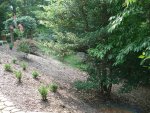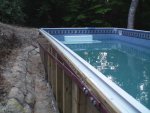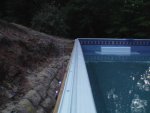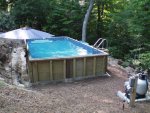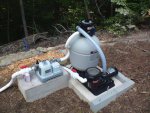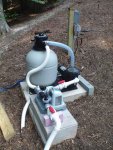First Post. New to forum.
I am about to start digging for installation of an On-ground 12' X 24' rectangular pool. Since the pool location is a relatively steep slope, a full inground was not an option. I will have to rent a bobcat and dig into the slope to create a level surface for the pool. The manufacturer of the pool tells me I can backfill on the uphill side and have the dirt contact the side, but I will install a retaining wall to avoid this. The pool is made by AquaStarMI.com and will arrive in a few weeks.
I have attached a few pics that show my rendering of the pool in the slope. I plan on doing all this myself and I have a question about the bottom prep before installing the liner. I plan on having a starting water depth of about 38" and I want to have a deeper tray that takes water depth to 52". I understand that it is common to use vermiculite to support the sides of this pan, but I'm wondering if this is necessary when my soil is a relatively heavy sand/clay mix. Can I just make sure there are no sharp objects in the sand/clay and set the liner in? The very bottom will have a sand base. Is there an alternative to vermiculite that is easy for a DIY homeowner?
Thanks,
John
I am about to start digging for installation of an On-ground 12' X 24' rectangular pool. Since the pool location is a relatively steep slope, a full inground was not an option. I will have to rent a bobcat and dig into the slope to create a level surface for the pool. The manufacturer of the pool tells me I can backfill on the uphill side and have the dirt contact the side, but I will install a retaining wall to avoid this. The pool is made by AquaStarMI.com and will arrive in a few weeks.
I have attached a few pics that show my rendering of the pool in the slope. I plan on doing all this myself and I have a question about the bottom prep before installing the liner. I plan on having a starting water depth of about 38" and I want to have a deeper tray that takes water depth to 52". I understand that it is common to use vermiculite to support the sides of this pan, but I'm wondering if this is necessary when my soil is a relatively heavy sand/clay mix. Can I just make sure there are no sharp objects in the sand/clay and set the liner in? The very bottom will have a sand base. Is there an alternative to vermiculite that is easy for a DIY homeowner?
Thanks,
John





